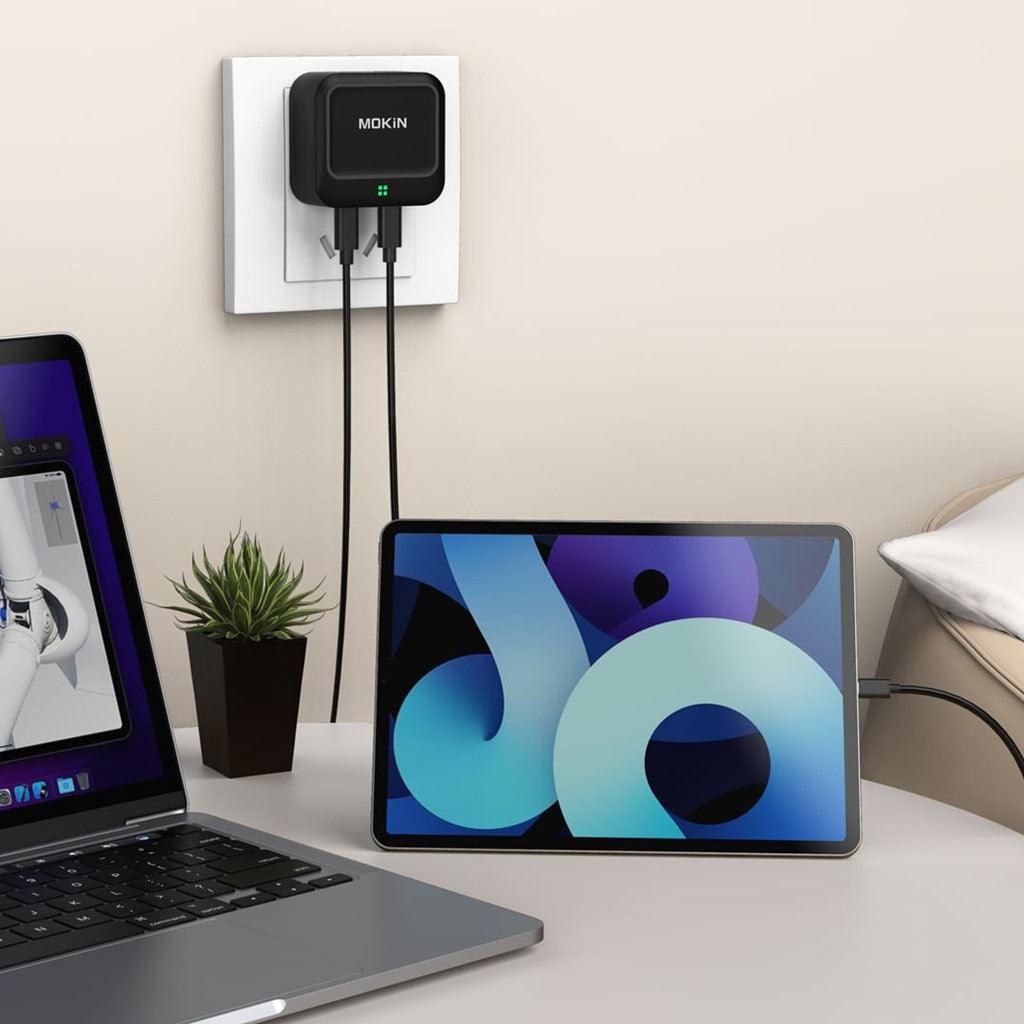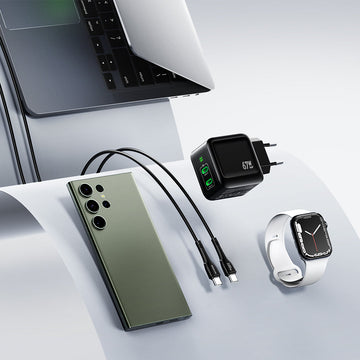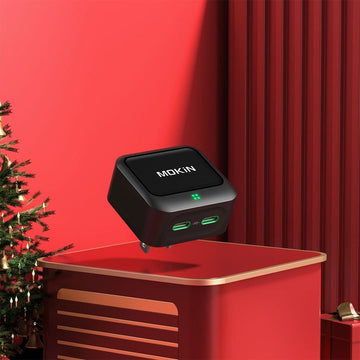Fast GaN Charging vs. Traditional Chargers: Is Wireless Charging Faster?
Charging has become an essential part of daily life, powering devices like smartphones, tablets, and laptops. Keeping our devices fully charged helps us stay connected, access information, and reach out for help in emergencies. With the rise of wireless charging, many are wondering if it’s faster or slower than traditional wired charging.
With the increasing reliance on cell phones and other electronic devices have also led to a growing demand for fast and efficient charging solutions. To meet this demand, Gallium Nitride (GaN) materials have emerged as a promising solution. This article is aim to discuss the efficiency of Fast GaN Charging in the context of wireless charging speed.
Fast GaN Charging vs. Traditional Chargers
The difference between GaN charger and ordinary charger is mainly reflected in its circuit design and service life.

First, adopted GaN material as the circuit device, so GaN charger is lower in resistance value and better in thermal stability, so it can be more effective for power conversion and electrical energy storage. Secondly, due to the GaN charger generate less heat during use, so can extend the service life of itself. Thanks to the excellent semiconductor performance and high electron mobility of GaN materials, so that they can automatically switch between AC and DC power sources, effectively reducing the size and weight of chargers.
As a new type of charger, advantages of GaN charger are as follows:
- Fast charging: GaN charger has higher charging efficiency, which can fully charge cell phones or other devices in a short time without long waiting.
- Low-temperature charging: GaN chargers have a more stable charging process, and the temperature rises slower during charging, which helps to reduce the risk of temperature during the charging process, preventing damage to phone performance because of over-heating during charging, extending the lifespan of battery.
- Reduced size: GaN's main strengths in power electronics are high efficiency, low loss and high frequency, and owing to the rapid development of modern design ,it is compact design and lightweight.
- Environmental protection: GaN charger does not use harmful substances in the production process, the impact on the environment is smaller. Above all the mentioned, those are the reasons why GaN chargers shine in the charger industry.
In fact, many traditional chargers which most of them are made of semiconductor silicon material is too inconvenient to carry for its bigger size and it is a burden for you coupled with the bigger screen display phone. Compared to the past, if you try to use the same volume of large chargers, then it will cause consumer distress, and GaN charger is just the right solution to the pain point. However, GaN chargers are usually more expensive compared to regular chargers. Therefore, when choosing a charger, you can make a choice based on your real needs and usage environment.
Is Wireless Charging Faster?
When discussing the charging rates of wireless chargers, several variables can significantly impact your phone's charging speed. Factors such as the current battery level, active applications, screen status, and ambient temperature all play a crucial role.
Different smartphone manufacturers have developed various strategies to manage charging rates to safeguard the phone's battery life.
Here is a comparison of charging rates under optimal and less ideal conditions:
| Scenario | Best Case Scenario | Worst Case Scenario |
|---|---|---|
| Battery Level | Almost depleted (<5%) | Nearly full (>80%) |
| Applications | No active apps, especially GPS-intensive ones | Multiple apps running, including GPS-based apps (e.g., maps) |
| Screen Status | Off | On |
| Temperature | Low (~20°C/68°F), in shade | High (30°C/86°F), in direct sunlight |
| Charge Rate | Increase of 1% every 2 minutes, or 30% increase per hour | Increase of 1% every 10 minutes, or 6% increase per hour |
100W wired vs 100W wireless charging test:
- Test performed using the iPhone 14pro smartphone

In the best-case scenario, with a nearly empty battery, no running apps, the screen turned off, and in a cooler environment, the observed charge rate is a 1% increase every 2 minutes, translating to a 30% increase in battery charge per hour.
Conversely, in the worst-case scenario with a nearly full battery, multiple applications running (including GPS-dependent ones), the screen on, and in hotter conditions (especially in direct sunlight), the charging efficiency can drop significantly, with only a 1% increase every 10 minutes, equating to about a 6% increase in battery level over an hour.
Let's keep the answer to this headline in suspense. Now please look at following two world-class experiments as follows via links and then draw accurate conclusions from them afterwards.
Note:
#Why Does Wireless Charging Seem Slow?
#100W wired vs 100W wireless charging test
According to the above world-class experiments mentioned in the links, there is no doubt that wireless charging is slower that wired charging. And from the content of the link, the speed of charging power can depend on the distance between receiver and the transmission, the present battery capacity of the phone, whether the screen of the electronic device is lit up when charging or whether there are too many applications are running simultaneously and the ambient charging temperature. But the conventional chargers will reduce the power because of the heat generated while charging, leading lower power.
Although classic cables won wired vs wireless charging race, it is recorded only a minute or two between key milestones and even a full charge. Fast wireless charging is virtually every bit as good as the best wired wall chargers, especially at high power levels. The real trade-off isn’t speed but heat, which, as we know, isn’t great for the longevity of internal smartphone components. But GaN chargers have large forbidden bandwidth, large critical breakdown electric field, high saturation electron drift speed, and stable chemical properties compared to traditional chargers made of traditional semiconductor silicon, which perfectly solves this problem.
Benefits of Fast GaN Charging
GaN charging technology offers several benefits, particularly in terms of charging speed and efficiency. Here are some key advantages:

- High Speed Charging: It deliver higher charging speeds significantly compared to traditional charging technologies. GaN chargers can provide wattages well beyond what conventional chargers can achieve. The efficient electron mobility in GaN allows for faster power delivery, leading to quicker charging times for electronic devices.
- Improved Efficiency: Fast GaN Charging technology is known for its high efficiency in power conversion. GaN semiconductors have lower energy loss during the conversion process compared to traditional silicon-based chargers. Thus, reduced energy loss means less heat generation, contributing to both the safety and efficiency of the charging process.
- Compact and Lightweight Design: GaN chargers are more compact and lightweight compared to chargers based on other materials like silicon. This makes them more portable and convenient for users on the go. The smaller form factor is achieved without compromising on power output, making GaN chargers ideal for travel and everyday use.
- Compatibility with Various Devices: Fast GaN Charging is compatible with diverse electronic devices, including smartphones, laptops, tablets, and other USB-powered gadgets. This versatility makes GaN chargers become a practical solution for users with multiple devices. Moreover, some GaN chargers come with multiple ports, allowing users to charge multiple devices simultaneously without sacrificing charging speed.
- Future-Proof Technology: As consumer electronics continue to demand higher power inputs for faster charging, GaN technology is well-positioned to meet these evolving needs.
- Reduced Environmental Impact: The higher efficiency of GaN chargers means more less wasted energy during the charging process. This contributes to a reduction in overall energy consumption and, consequently, lower environmental impact.
Case Studies and Testimonials
All of our points above are supported by strong arguments, as the following links show success stories that demonstrate the speed and reliability of Fast GaN Charging.

| Product Name | Features | Price | Reviews Summary | Buy Now Button |
|---|---|---|---|---|
| MOKiN Mini 40W Dual USB C Wall Charger | Dual USB C, 40W GaN Tech, Compact, Foldable Plug, PI Technology for Safety | $23.99 | Users praise its portability and fast charging capabilities. | Buy Now |
| MOKiN 120W 4-Port Desktop USB C Charging Station | 120W total output, GaN+ Tech, Charges 4 devices, 100W USB-C port for laptops | $49.99 | Appreciated for its ability to charge multiple devices efficiently. | Buy Now |
| MOKiN High-Speed 100W USB C Gan Charger | 100W Power, GaN II Tech, Charges 2 devices, Full charge MacBook Pro 16’’ in 1.8h, Included USB-C cable | $59.99 | Customers value the high-speed charging and compatibility. | Buy Now |
# What is GAN charger – A Must-Have for You | GP Batteries UK
#Which Charges Your Phone Faster: Wireless or Wired?
The Role of Technological Advancements
The evolution of wireless charging technology has been driven by innovation, addressing challenges and enhancing the overall efficiency and accessibility of wireless charging solutions.
Here's how technological advancements, including Fast GaN Charging, contribute to faster and more accessible wireless charging. Fast GaN Charging, with its higher efficiency in power conversion, is making a significant impact on wireless charging. Efficient power transfer ensures that more energy from the charger is effectively utilized for charging the devices, reducing energy loss and improving overall charging speed.
Technological innovations have led to higher power outputs in wireless charging systems. In particular, it enables higher wattages, providing faster charging speeds for more compatible devices. With increased power output, wireless chargers can deliver more energy to devices within a shorter time, addressing one of the historical limitations of wireless charging.
Integrating GaN technology into wireless chargers enhances their efficiency and power-handling capabilities. GaN chargers operate at high frequencies and voltages, making them well-suited for applications that demand fast and efficient power delivery, enabling faster charging without compromising on safety or reliability.
Advanced charging algorithms play a crucial role in optimizing the wireless charging process. These algorithms assess the device's power requirements and adjust the charging parameters accordingly, ensuring the fastest and safest charging possible. By continually monitoring and adapting to the charging environment, these algorithms contribute to the overall efficiency and speed of wireless charging systems.
Innovations in coil design and placement have improved the spatial freedom and alignment tolerance in wireless charging systems, helping mitigate some of the historical challenges associated with precise device positioning, contributing to a more accessible and user-friendly wireless charging experience.
Wireless charging is increasingly being integrated with other emerging technologies such as the Internet of Things (IoT) and smart home ecosystems. This integration not only enhances the functionality of wireless charging systems but also contributes to a more seamless and accessible user experience.
The integration of wireless charging into everyday devices, from smartphones to electric vehicles, is a testament to the ongoing efforts to make this technology more widely adopted and convenient for users.
In conclusion, technological advancements, with a particular emphasis on Fast GaN Charging, have been instrumental in pushing the boundaries of wireless charging speed. Continuous innovation, adaptive algorithms, and the integration of advanced materials contribute to a more efficient, faster, and accessible wireless charging experience for consumers. As these technologies continue to evolve, we can expect further improvements in wireless charging speed and usability.
Conclusion
Viewed as a whole article, we are still able to choose which type of charger real need indeed before purchasing, analyzing from charging efficiency, charging time, heat generation, size and multi-port device compatibility, and price. Fast GaN Charging have positioned wireless charging as a promising technology, the future balance between wireless and traditional charging methods depends on ongoing developments in standardization, user experience, cost, and technological innovation. It is potential for wireless charging to realize more user-friendly function in cost-effective way.

MOKiN 13-IN-1 USB-C Laptop Charging Station with 2.26-inch LCD Smart Display








